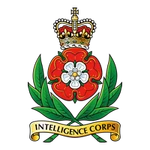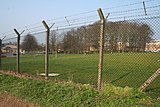| Intelligence Corps | |
|---|---|
 Badge of the Intelligence Corps | |
| Active |
1914–29 15 July 1940– |
| Country | United Kingdom |
| Allegiance | Queen Elizabeth II |
| Branch | Army |
| Role | Military Intelligence |
| Size | 5 battalions |
| HQ Directorate Intelligence Corps |
Chicksands (1997–) Templer Barracks (−1997) Maresfield |
| Nickname(s) | Int Corps, Greenfly |
| Motto(s) |
Manui Dat Cognitio Vires Knowledge gives strength to the arm |
| Beret | Cypress green |
| March |
Rose & Laurel (quick) Purcell’s Trumpet Tune and Ayre (slow) |
| Website | http://army.mod.uk/intelligence/ |
| Commanders | |
| Colonel-in-Chief | HRH The Duke of Edinburgh KG, KT, OM, GBE, AC, QSO, PC |
| Ceremonial chief | General Sir Nick Houghton |
The Intelligence Corps (Int Corps) is one of the corps of the British Army. It is responsible for gathering, analysing and disseminating military intelligence and also for counter-intelligence and security. The Director of the Intelligence Corps is a Brigadier.
History[]
At the end of the 19th century, the first movements towards establishing a group specifically tasked with collecting military intelligence for the British Army were looked at, but it was viewed as not playing by the rules, and a bit underhand[citation needed]. By the 1900s, intelligence gathering had become better understood, to the point where a counter-intelligence organisation was formed – MI5 by the Directorate of Military Intelligence (DoMI) under Captain (later Major-General) Vernon Kell. Overseas intelligence gathering began in 1912 by MI6 under Commander (later Captain) Mansfield Smith-Cumming.
First World War[]
Although the first proposals to create an intelligence corps came in 1905, the first Intelligence Corps was formed in August 1914 and originally included only officers and their servants. It left for France on 12 August 1914.[1] The Royal Flying Corps was formed to monitor the ground, and provided aerial photographs for the Corps to analyse. Prisoner-of-war and refugee debriefing techniques were developed.
Irish War of Independence[]
During the Irish War of Independence, Intelligence Corps operatives were used in a vain battle to defeat Michael Collins and the Irish Republican Army. In fact, the British secret service agents who made up The Cairo Gang were overwhelmingly Intelligence Corps operatives. On Bloody Sunday, 1920, twelve of these agents were assassinated at their lodgings by Collins' private death squad, "The Twelve Apostles".
Due to this and similar failures, the Intelligence Corps was disbanded in 1929.[2]
Second World War[]
On 19 July 1940 a new Intelligence Corps was created by Army Order 112 and has existed since that time. The Army had been unprepared for collecting intelligence for deployment to France, and the only intelligence had been collected by Major Sir Gerald Templer. The Corps trained its operatives to parachute at RAF Ringway, who were then dropped over France as part of the Special Operations Executive (SOE). Intelligence Corps officers were involved in forming the highly-effective Long Range Desert Group, and the Corps officer Lt Col Peter Clayton was one of the four founders of the Special Air Service (SAS). Around 40% of British Army personnel at Bletchley Park were in the Intelligence Corps,[3] and another important function was analysing aerial photography for ground support.
Cold War[]
The Corps gained its regimental march in 1956, first played at Kneller Hall, the home of the Royal Military School of Music. From August 1957, the Corps first had a permanent cadre of officers; previously all personnel serving in the corps were officers from other parts of the Army, on occasional tours. Throughout the period of the Cold War, Intelligence Corps Officers and NCOs (with changed insignia) were posted behind the Iron Curtain, in East Germany, to join in the intelligence gathering activities of the British Commanders'-in-Chief Mission to the Soviet Forces in Germany (Brixmis).[4]
Designation[]
On 1 February 1985 the corps was officially declared an 'Arm' (combat support) instead of a 'Service' (rear support).
Commanders[]
- Major T. G. J. Torrie, August – September 1914
- Captain Archibald Wavell, 1st Earl Wavell, August – December 1914
- Major Dunnington Jefferson, December 1914 – 1918
Corps traditions[]
Intelligence Corps personnel wear a distinctive cypress green beret with a cap badge consisting of a union rose (a red rose with a white centre) between two laurel branches and surmounted by a crown. (According to the late Gavin Lyall, the I-Corps badge is referred to jokingly as "a rampant pansy resting on its laurels")Their motto is Manui Dat Cognitio Vires ("Knowledge gives Strength to the Arm"). The corps' quick march is "The Rose & Laurel" while its slow march is Purcell's "Trumpet Tune & Ayre".
Owing to the colour of their beret, Intelligence Corps personnel are often referred to as 'green slime' or 'muppets'.[5]
Locations[]
Their headquarters, formerly at Maresfield, East Sussex, then Templer Barracks at Ashford, Kent, moved in 1997 to the former Royal Air Force station at Chicksands in Bedfordshire along with the Defence Intelligence and Security Centre and the Intelligence Corps Museum, in Campton and Chicksands off a roundabout of the A507 near the junction with the A600.
Training and promotion[]
The corps has a particularly high proportion of commissioned officers, many of them commissioned from the ranks, and also a high percentage of female members. Non-commissioned personnel join as an Operator Military Intelligence (OPMI) or Operator Military Intelligence (Linguist) (OPMI(L)). They do basic 14-week military training at the Army Training Centre Pirbright. OPMI will complete a 27-week special-to-arm training at Templer Training Delivery Wing, Chicksands, at the end of which they are promoted to Lance Corporal. OPMI(L) will complete a 78-week language course at Chicksands, during which they will be promoted to Lance Corporal and also qualify for specialist pay.
Promotion continues to be more rapid than in most other corps. Officers complete their training at Sandhurst and then a Junior Officers Course (JOC) to qualify them as Intelligence Corps Officers.

Chicksands camp
Structure[]
Units of the Corps include;
- Defence Intelligence Fusion Centre, RAF Wyton
- Joint Intelligence Training Group, RAF Chicksands
- Land Intelligence Fusion Centre, Denison Barracks
- 1st Military Intelligence Battalion, Catterick Garrison
- 2nd Military Intelligence (Exploitation) Battalion, RHQ at Trenchard Lines
- 3rd Military Intelligence Battalion (Volunteers) [Paired with 1 MI Battalion]
- Regimental Headquarters in London
- 31 Military Intelligence Company in London
- 33 Military Intelligence Company in Cambridge
- 34 Military Intelligence Company in London
- 4th Military Intelligence Battalion, Bulford Barracks [Supporting 3rd UK Division's HQ]
- 5th Military Intelligence Battalion (Volunteers) [Paired with 1 MI Battalion]
- Regimental Headquarters at Redford Barracks
- 51 Military Intelligence Company in Edinburgh
- 52 Military Intelligence Company at Napier Armoury
- 53 Military Intelligence Company in Leeds
- 6th Military Intelligence Battalion (Volunteers) [Paired with 2 MI Battalion]
- Regimental Headquarters in Manchester
- 61 Military Intelligence Company in Manchester
- No.1 Detachment in Milton Keynes
- 62 Military Intelligence Company at Thiepval Barracks
- 63 Military Intelligence Company in Birmingham
- 7th Military Intelligence Battalion (Volunteers) [Paired with 4 MI Battalion]
- Regimental Headquarters in Bristol
- 71 Military Intelligence Company in Bristol
- No.1 Detachment at Raglan Barracks
- No.5 Detachment at Wyvern Barracks
- 72 Military Intelligence Company in Southampton
- Detachment at Wyvern Barracks
- 73 Military Intelligence Company in Thatcham
Notable personnel[]
References[]
- ↑ Clayton 1996, p. 18-20.
- ↑ History of The Intelligence Corps, pp. 3
- ↑ History of The Intelligence Corps, pp. 4
- ↑ Gibson 2012, p. 57
- ↑ http://www.arrse.co.uk/wiki/Intelligence_Corps
External links and further reading[]
- Official website
- Intelligence Corps Association
- 3 MI Bn (V) – London
- 5 MI Bn (V) – Coulby Newham
- The Intelligence Corps in the Second World War The Services 1930 – 1956 at www.BritishMilitaryHistory.co.uk
- Clayton, Anthony (1996). Forearmed: History of the Intelligence Corps. Brassey's (UK) Ltd. ISBN 978-0080377018.
- Gibson, Steve (2012). Live and Let Spy: Brixmis the Last Cold War Mission. The History Press, Stroud, Glos.. ISBN 978-0-7524-6580-7.
Order of precedence[]
The original article can be found at Intelligence Corps and the edit history here.